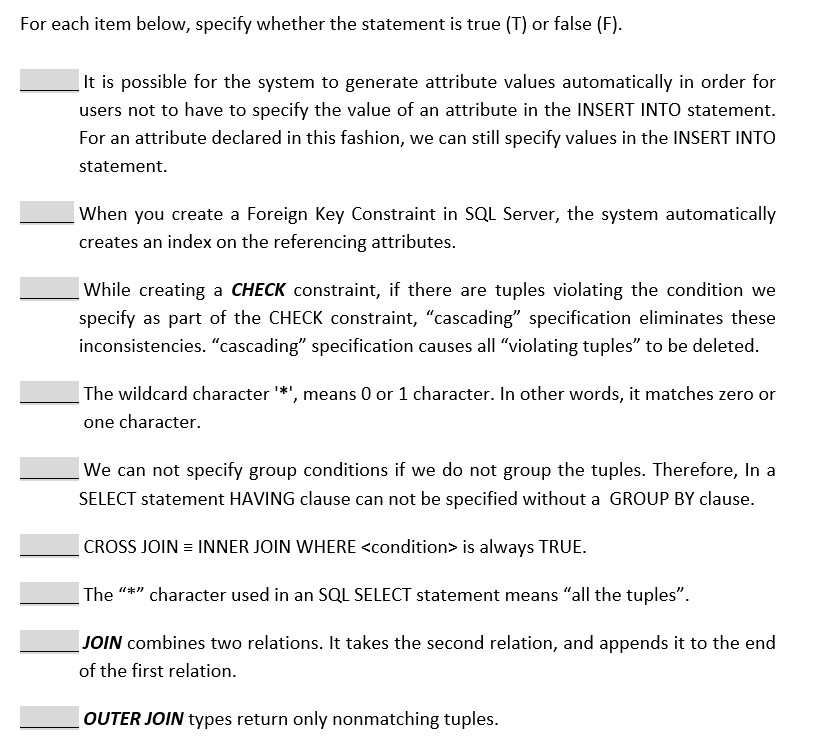For each item below, specify whether the statement is true (T) or false (F). It is possible for the system to generate attribute values automatically in order for users not to have to specify the value of an attribute in the INSERT INTO statement. For an attribute declared in this fashion, we can still specify values in the INSERT INTO statement. When you create a Foreign Key Constraint in SQL Server, the system automatically creates an index on the referencing attributes. While creating a CHECK constraint, if there are tuples violating the condition we specify as part of the CHECK constraint, "cascading" specification eliminates these inconsistencies. "cascading" specification causes all "violating tuples" to be deleted. The wildcard character *', means 0 or 1 character. In other words, it matches zero or one character. We can not specify group conditions if we do not group the tuples. Therefore, In a SELECT statement HAVING clause can not be specified without a GROUP BY clause. | CROSS JOIN = INNER JOIN WHERE is always TRUE. The ´character used in an SQL SELECT statement means "all the tuples". JOIN combines two relations. It takes the second relation, and appends it to the end of the first relation. OUTER JOIN types return only nonmatching tuples.
For each item below, specify whether the statement is true (T) or false (F). It is possible for the system to generate attribute values automatically in order for users not to have to specify the value of an attribute in the INSERT INTO statement. For an attribute declared in this fashion, we can still specify values in the INSERT INTO statement. When you create a Foreign Key Constraint in SQL Server, the system automatically creates an index on the referencing attributes. While creating a CHECK constraint, if there are tuples violating the condition we specify as part of the CHECK constraint, "cascading" specification eliminates these inconsistencies. "cascading" specification causes all "violating tuples" to be deleted. The wildcard character *', means 0 or 1 character. In other words, it matches zero or one character. We can not specify group conditions if we do not group the tuples. Therefore, In a SELECT statement HAVING clause can not be specified without a GROUP BY clause. | CROSS JOIN = INNER JOIN WHERE is always TRUE. The ´character used in an SQL SELECT statement means "all the tuples". JOIN combines two relations. It takes the second relation, and appends it to the end of the first relation. OUTER JOIN types return only nonmatching tuples.
Chapter13: Views
Section: Chapter Questions
Problem 2MC
Related questions
Question
Write true or false for each.

Transcribed Image Text:For each item below, specify whether the statement is true (T) or false (F).
It is possible for the system to generate attribute values automatically in order for
users not to have to specify the value of an attribute in the INSERT INTO statement.
For an attribute declared in this fashion, we can still specify values in the INSERT INTO
statement.
When you create a Foreign Key Constraint in SQL Server, the system automatically
creates an index on the referencing attributes.
While creating a CHECK constraint, if there are tuples violating the condition we
specify as part of the CHECK constraint, "cascading" specification eliminates these
inconsistencies. "cascading" specification causes all "violating tuples" to be deleted.
The wildcard character '*', means 0 or 1 character. In other words, it matches zero or
one character.
We can not specify group conditions if we do not group the tuples. Therefore, In a
SELECT statement HAVING clause can not be specified without a GROUP BY clause.
CROSS JOIN = INNER JOIN WHERE <condition> is always TRUE.
|The "*" character used in an SQL SELECT statement means "all the tuples".
JOIN combines two relations. It takes the second relation, and appends it to the end
of the first relation.
OUTER JOIN types return only nonmatching tuples.
Expert Solution
This question has been solved!
Explore an expertly crafted, step-by-step solution for a thorough understanding of key concepts.
Step by step
Solved in 2 steps

Knowledge Booster
Learn more about
Need a deep-dive on the concept behind this application? Look no further. Learn more about this topic, computer-science and related others by exploring similar questions and additional content below.Recommended textbooks for you


A Guide to SQL
Computer Science
ISBN:
9781111527273
Author:
Philip J. Pratt
Publisher:
Course Technology Ptr

Database Systems: Design, Implementation, & Manag…
Computer Science
ISBN:
9781285196145
Author:
Steven, Steven Morris, Carlos Coronel, Carlos, Coronel, Carlos; Morris, Carlos Coronel and Steven Morris, Carlos Coronel; Steven Morris, Steven Morris; Carlos Coronel
Publisher:
Cengage Learning


A Guide to SQL
Computer Science
ISBN:
9781111527273
Author:
Philip J. Pratt
Publisher:
Course Technology Ptr

Database Systems: Design, Implementation, & Manag…
Computer Science
ISBN:
9781285196145
Author:
Steven, Steven Morris, Carlos Coronel, Carlos, Coronel, Carlos; Morris, Carlos Coronel and Steven Morris, Carlos Coronel; Steven Morris, Steven Morris; Carlos Coronel
Publisher:
Cengage Learning

Database Systems: Design, Implementation, & Manag…
Computer Science
ISBN:
9781305627482
Author:
Carlos Coronel, Steven Morris
Publisher:
Cengage Learning